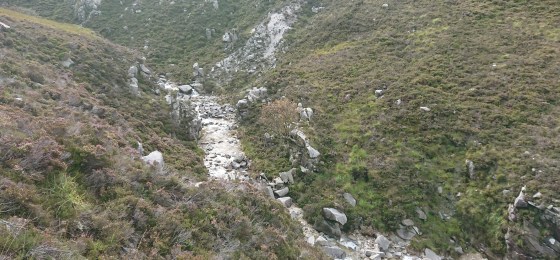
Evolution and discovery on the Isle of Arran
Earlier this year a trip to the Scottish Isle of Arran to see its endemic Sorbus species led to an exciting discovery.
We have 38 endemic Sorbus species, some would consider them microspecies, here in the British Isles. All but two of them were recently assessed, as part of the European Red List of Trees, as threatened with extinction, with the majority meeting the IUCN criteria for Critically Endangered or Endangered. Each is morphologically discernible and reproductively isolated (geographically or reproductively), with fascinating evolutionary stories. They also face devastating threats.
One of these is the Menai Strait whitebeam (Sorbus arvonicola), which occurs along a one-kilometre stretch of the Menai Strait. In 2018, we at FossilPlants instigated a project to bring this species into cultivation as ex-situ back up to the group of less than 30 mature plants that grows a few metres from high tide on a rapidly eroding stretch of shoreline. This subsequently led us on a mission to better understand the incredible evolutionary story of the whitebeams and their conservation.
A microspecies?
But what is a microspecies? I hear you ask.
In the British Isles, we have four species of Sorbus that reproduce in the normal fashion i.e. they are diploid and reproduce sexually. However, others are polyploid and apomictic – they reproduce clonally via their seed. Their reproductive capability is complicated further by a process called pseudogamy, where pollination is required for development of the seed endosperm but not the embryo. Some are obligate apomicts whilst others occasionally reproduce sexually (known as facultative apomicts) leading to more genetic diversity and speciation. Some taxonomists do not consider these apomictic plants, which are not very genetically diverse, to be species and prefer to either place them with their nearest diploid species or call them microspecies.
This fascinating reproductive ability is just one of the myriad ways in which plants reproduce and I prefer to call them species. The team that came together in 2016 to create the European Red List of Trees echoed this, applying the species concept for both sexual and apomictic species, in accordance with IUCN Red List guidelines.
Unique Arran Sorbus
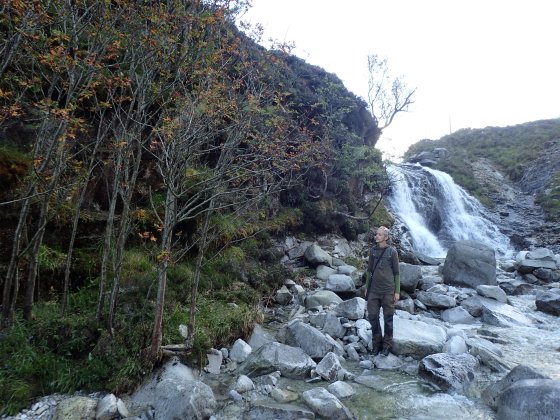
Robbie Blackhall-Miles with the Sorbus pseudomeineichii tree
The three unique Arran Sorbus taxa are the result of crosses between rowan (S. aucuparia) and rock whitebeam (S. rupicola). S. arranensis is an apomictic hybrid between S. aucuparia and S. rupicola; S. pseudofennica a backcross (also apomictic) between S. arranensis and S. aucuparia; and S. pseudomeinichii a further backcross (also proven to reproduce apomictically) between S. pseudofennica and S. aucuparia (Coleman, 2014).
Sorbus pseudomeinichii was published as a new endemic tree from Arran in 2006 and has leaf morphology intermediate between S. pseudofennica and S. aucuparia (Robertson & Sydes, 2006). Three trees were found originally: two mature and one sapling. Subsequent flooding has destroyed one tree and it is presumed grazing deer have killed the sapling. This has left a single mature individual on the streamside of the Catacol Burn, making it arguably one of the rarest trees in the world (Coleman, 2014; Rich et al., 2010).
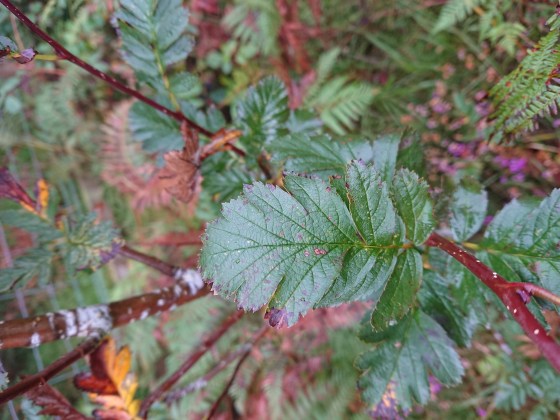
Sorbus pseudofennica leaf
Hunting for whitebeams
My partner (Ben) and I set off on a journey to Scotland to meet these trees that have truly fascinating evolutionary stories. Whilst there, we made an incredibly exciting discovery.
On September 15th 2020, we visited Glen Catacol in the north-west of the island, with the sole intention of observing the valley’s whitebeams and rowans. At the trailhead, there is a small enclosure of planted trees, originally propagated by the Royal Botanic Gardens, Edinburgh. These comprise the five taxa involved in a complex sequence of hybridisation that led to the evolution of the three endemic Sorbus species to the Isle of Arran. We familiarised ourselves with the taxa found in Glen Catacol in their pristine state: rowan (S. aucuparia L.), Arran whitebeam (S. arranensis Hedl.), Arran service-tree (S. pseudofennica E. F. Warb.) and the Catacol whitebeam or false rowan (S. pseudomeinichii Ashley Robertson).
From there, we followed the Diomhan Burn tributary to view trees along the entire length of its gorge and walked over the nearby 527m hill of Bienn Tarsuinn, to see all the trees in Glen Catacol. Most are protected from grazing within deer-proof enclosures, with only those trees in the steepest and most inaccessible gorge sections left unprotected (as is the case for the single tree of S. pseudomeinichii).
A special find
Before reaching the majority of the trees, we observed two lone, unprotected and heavily grazed Sorbus just below the first of two waterfalls. One was a rowan but the other had larger terminal leaflets, some of which had lobes resembling fused leaflets, and just four to five (sometimes six) pairs of lateral leaflets across the majority of its remaining autumnal foliage. With piqued interest, we documented the plant and its position and moved on to visit the lone S. pseudomeinichii plant in its gorge.
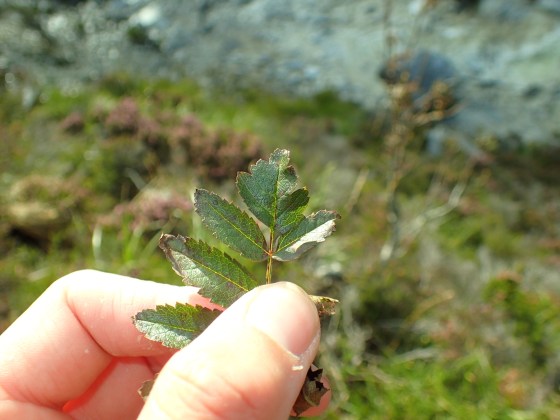
Sorbus pseudomeinichii leaf
On seeing the large S. pseudomeinichii tree, with its multiple vertical trunks, and leaves and individual leaflets in their weather-battered state, we realised that the tree we had seen higher up the valley may also be a S. pseudomeinichii. We continued out of the valley with many questions about the trees we had seen and our discovery.
After consulting with experts (Kate Sampson, Henry Murdo, Dr Tim Rich and Dr Ashley Robertson), we positively identified the plant as S. pseudomeinichii with Dr. Robertson confirming this as a new location for the taxa, rather than the rediscovery of one of the two previously known plants that had been lost.
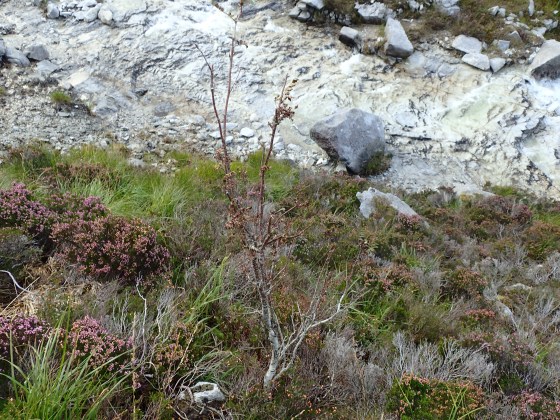
Newly discovered Sorbus pseudomeinichii tree
All three Sorbus taxa endemic to Arran are considered threatened with extinction (Rivers et al., 2019), so for the Critically Endangered Sorbus pseudomeinichii, this discovery is of great conservation significance. Whether species or microspecies, all of this evolutionary complex should be conserved because of their intricate ability to evolve. This second plant needs further investigation and protection from grazing. Efforts are being made by multiple stakeholders on Arran to restore its woodlands and to protect the stands of surviving trees that cling on in the isolated gorges and glens. Conservation initiatives such as these will enable the Sorbus to continue their story of evolution, creating resilience and genetic diversity for the future.
Thanks
Dr Tim Rich, Dr Ashley Robertson, Kate Sampson (National Trust for Scotland), Henry Murdo, John Nicholson (National Trust for Scotland), and Ben Ram.
References
- Robertson A. & Sydes C. 2006. Sorbus pseudomeinichii, a new endemic Sorbus (Rosaceae) microspecies from Arran, Scotland. Watsonia, 26: 9–14
- Rich, T.C.G., Houston, L., Robertson, A. & Proctor, M. C. F. 2010. Whitebeams, Rowans and Service Trees of Britain and Ireland. A Monograph of British and Irish Sorbus L. B.S.B.I. Handbook No. 14. Botanical Society of the British Isles, London.
- Coleman, M. 2014. Arran’s unique trees. The Royal Botanic Garden, Edinburgh. (URL: https://stories.rbge.org.uk/archives/13616)
- Rivers, M.C., Beech, E., Bazos, I., Bogunić, F., Buira, A., Caković, D., Carapeto, A., Carta, A., Cornier, B., Fenu, G., Fernandes, F., Fraga, P., Garcia Murillo, P.J., Lepší, M., Matevski, V., Medina, F.M., Menezes de Sequeira, M., Meyer, N., Mikoláš, V., Montagnani, C., Monteiro-Henriques, T., Naranjo Suárez, J., Orsenigo, S., Petrova, A., Reyes-Betancort, J.A., Rich, T., Salvesen, P.H., Santana López, I., Scholz, S., Sennikov, A., Shuka, L., Silva, L.F., Thomas, P., Troia, A., Villar, J.L. & Allen, D.J. 2019. European Red List of Trees. IUCN, Cambridge, UK and Brussels, Belgium. viii + 60pp DOI: https://doi.org/10.2305/IUCN.CH.2019.ERL.1.en.